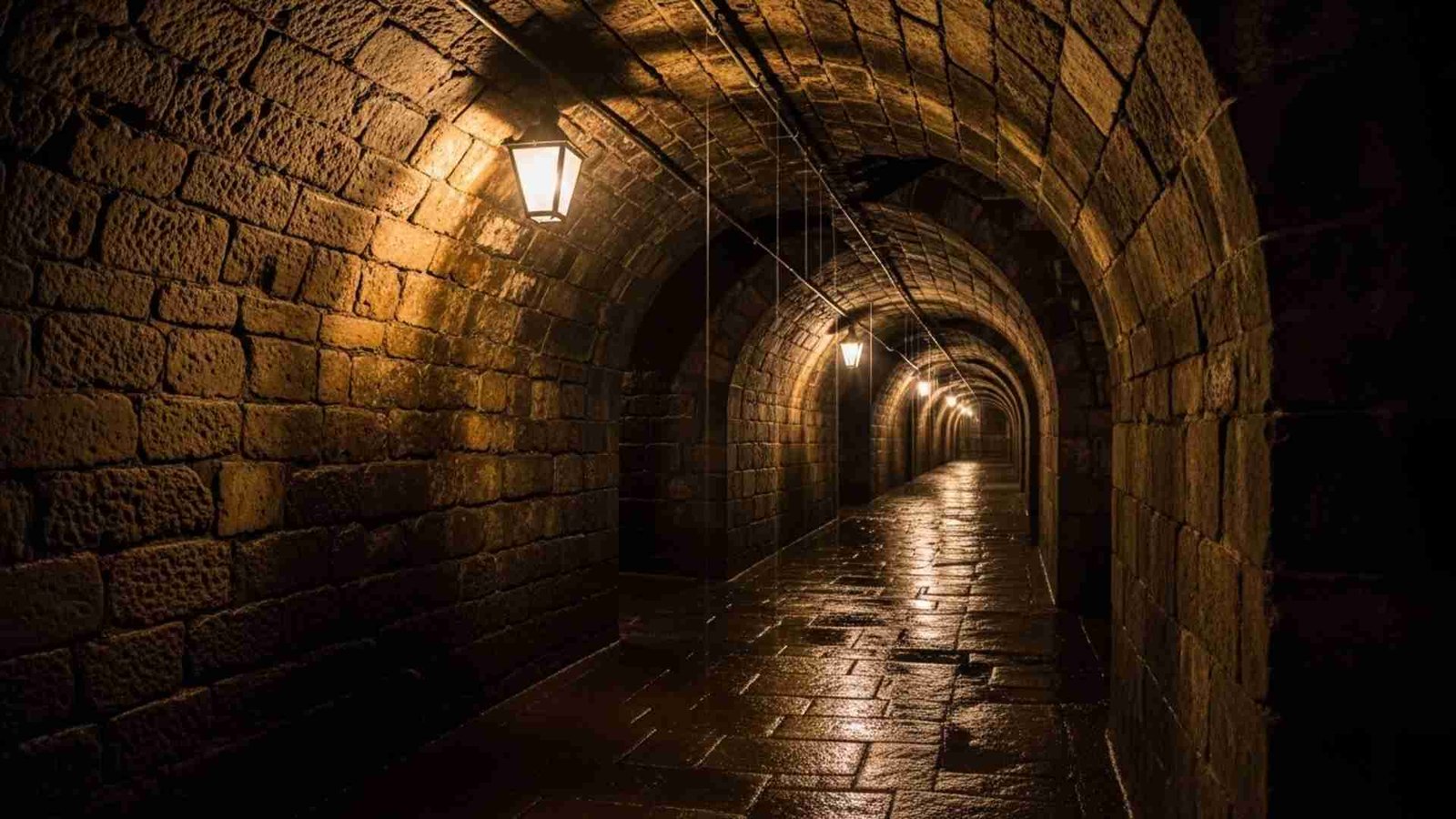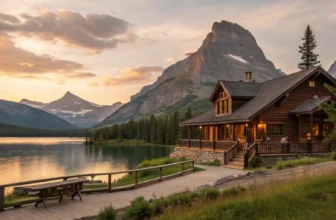

Air is colder in places where history refuses to rest. Footsteps echo down empty corridors, whispers cling to stone walls, and travelers find themselves caught between curiosity and unease. In an age when travel often seeks the picturesque, a new kind of explorer is drawn to the shadows — those who chase truth through tragedy, beauty through decay.
Dark tourism isn’t about fear; it’s about understanding what endures when light fades. Ahead lie journeys that test courage, stir empathy, and reveal the haunting pulse of the past — for those willing to look where most dare not tread.
1. Chernobyl Exclusion Zone, Ukraine – A Frozen Moment in Time

Few places in the world command silence like Chernobyl. Walking through the overgrown streets of Pripyat feels like stepping into a time capsule left mid-breath — children’s toys abandoned in classrooms, Ferris wheels rusting in eerie stillness, and nature reclaiming what humans once controlled. This ghost city, shaped by tragedy, has become a pilgrimage site for those fascinated by the power — and peril — of progress. The quiet hum of the Geiger counter is a chilling soundtrack to a place where time simply stopped in 1986.
It’s not all gloom, though. There’s a strange beauty in seeing wild horses roam freely or saplings sprouting through broken pavement. Guides share stories of heroism and sacrifice that humanize what might otherwise feel like a dystopian wasteland. Visitors often describe a deep emotional resonance here — a realization of how fragile civilization can be.
Practical Information:
- Best Season: April–October for accessible roads and comfortable weather; winters are freezing but atmospheric.
- Getting There: Day tours operate from Kyiv (about 2 hours away) and include all permits.
- Duration: A full-day tour or overnight stay in nearby Chernobyl town.
- Must-Do: Visit the Ferris wheel in Pripyat, Duga Radar, and Reactor 4’s viewing platform.
- Budget: Expect $100–$200 for guided tours.
- Etiquette: Avoid touching structures or removing artifacts; it’s a memorial, not a museum.
- Photography: Early morning light captures haunting shadows and fog beautifully.
2. Auschwitz-Birkenau Concentration Camp, Poland – Remembering Humanity’s Darkest Hour

Auschwitz is not a destination you “visit” — it’s one you bear witness to. Walking under the iron sign reading Arbeit Macht Frei sends a chill that words can’t quite contain. The air feels heavy, not just from history, but from collective memory. Barracks filled with personal belongings — shoes, suitcases, strands of hair — remind every visitor that these were not statistics, but lives interrupted. It’s a place that forces reflection rather than reaction.
Guides lead with compassion, ensuring silence when it’s due and context where it’s needed. Many describe the visit as emotionally exhausting yet necessary — an education in empathy, remembrance, and responsibility. The quiet rustle of wind through the birch trees surrounding Birkenau is one of the most poignant sounds you’ll ever hear.
Practical Information:
- Best Season: Spring or autumn, when crowds thin and temperatures are mild.
- Getting There: Buses and trains run daily from Kraków (about 90 minutes).
- Duration: Half-day to full-day guided visit.
- Must-Do: Join a guided historical tour for deeper understanding.
- Budget: Admission is free; guided tours cost around $15–$30.
- Etiquette: Maintain silence and avoid selfies or loud conversation. Dress respectfully.
- Photography: Allowed in most areas, but be mindful of sensitivity.
3. Salem, Massachusetts, USA – The Town That Never Escaped Its Shadows

Salem is where history, hysteria, and Halloween collide. Once the site of the infamous 1692 witch trials, it has since embraced its dark past with a fascinating blend of reverence and revelry. Cobblestone streets lined with witch-themed boutiques and candlelit museums make it feel both theatrical and authentic. But beyond the tourist trappings lies a deeper story — one about fear, injustice, and human psychology.
Visit in the quiet months, and you’ll sense the weight of its history more keenly. The Witch Trials Memorial, with names of the condemned etched in stone, is haunting in its simplicity. Local guides, often descendants of early settlers, bring the past alive with stories that blur the line between myth and memory.
Practical Information:
- Best Season: October for spooky festivities, or spring for quieter exploration.
- Getting There: Just 40 minutes north of Boston by train or car.
- Duration: 2–3 days to balance museums, tours, and historic walks.
- Must-Do: Witch Museum, Old Burying Point Cemetery, and House of the Seven Gables.
- Budget: Mid-range destination; entry fees around $10–$25 per site.
- Etiquette: Respect memorial sites and local residents — this is still a living town.
- Photography: Beautiful twilight shots near Derby Wharf capture the gothic charm.
4. The Catacombs of Paris, France – The Empire of the Dead

Beneath Paris’s romantic façade lies an underground world that few dare to imagine. The Catacombs of Paris stretch for miles beneath the city, holding the remains of more than six million people. Bones stacked in perfect symmetry form eerie corridors of skulls and femurs — a morbid kind of artistry created to solve the city’s overcrowded cemeteries in the 18th century. The silence down here is almost sacred, broken only by dripping water and the soft echo of footsteps.
Stepping into the Catacombs is a confrontation with mortality — yet, strangely, it’s also serene. The artistry of the arrangements, the Latin inscriptions about death and eternity, and the steady rhythm of the tunnels make it feel less macabre and more meditative. Locals once called it L’Empire de la Mort — The Empire of the Dead — and it’s hard not to feel humbled walking among so many anonymous souls.
Practical Information:
- Best Season: Year-round; temperatures underground stay around 14°C (57°F).
- Getting There: Easily accessible via Denfert-Rochereau Metro Station.
- Duration: 1–2 hours (guided tours recommended).
- Must-Do: Visit official sections only; secret tunnels are illegal and dangerous.
- Budget: Around €30 for tickets; book early to skip long lines.
- Etiquette: Keep noise low; no flash photography.
- Photography: Soft natural or candle-like lighting best captures the atmosphere.
5. Pompeii, Italy – The City That Died Twice

Pompeii is less a ruin and more a revelation — a city frozen mid-breath when Mount Vesuvius erupted in 79 AD. Streets, villas, frescoes, and even bakeries remain astonishingly intact, offering a haunting snapshot of Roman life abruptly ended. The plaster casts of victims, caught in their final moments, are both heart-wrenching and mesmerizing.
Exploring Pompeii is a sensory experience: the crunch of ancient cobblestones, the smell of volcanic dust, the Mediterranean sun on your back as you walk through history’s most famous tragedy. It’s a reminder that nature, not time, is the ultimate storyteller. Many visitors describe a strange duality here — awe at the preservation, grief for the humanity lost.
Practical Information:
- Best Season: April–June or September–October for mild weather.
- Getting There: Take the Circumvesuviana train from Naples (about 30–40 minutes).
- Duration: Half-day to full-day exploration.
- Must-Do: Visit the Villa of Mysteries and the Forum; climb nearby Mount Vesuvius.
- Budget: Entry €18; guided tours add depth.
- Etiquette: Be mindful around preserved remains; it’s a memorial as much as a site.
- Photography: Early morning offers dramatic light and fewer tourists for powerful shots.
6. Eastern State Penitentiary, Pennsylvania, USA – Where Silence Screamed

Long before Hollywood made prisons terrifying, Eastern State Penitentiary perfected the art of isolation. Built in 1829, this fortress-like structure in Philadelphia was designed not to punish the body, but to break the mind — inmates lived in complete silence, even eating and exercising alone. The concept of “penitence” gave birth to the word penitentiary, and its haunting corridors still whisper those early experiments in reform.
Today, the penitentiary stands frozen in crumbling decay — paint peeling, steel doors rusting, and shafts of light cutting through narrow cells. Visitors often describe a sensation of being watched, even when alone. Perhaps it’s the echo of Al Capone’s footsteps; the infamous gangster once served time here and furnished his cell lavishly, a strange comfort in a place built for despair.
Practical Information:
- Why Go: Few places blend history, architecture, and unease so seamlessly.
- Unique Angle: Visit during the Terror Behind the Walls event each October, when the prison transforms into one of the world’s most atmospheric haunted attractions.
- Time Needed: 2–3 hours for both the historical and immersive sides.
- Access: A short walk or drive from downtown Philadelphia.
- Insider Tip: Rent the audio tour narrated by Steve Buscemi — it’s both eerie and poetic.
7. Transylvania, Romania – More Than Dracula’s Shadow

Forget Hollywood clichés — Transylvania isn’t just about vampires; it’s a region wrapped in folklore, forests, and a haunting beauty that lingers long after you’ve left. Mist rolls over the Carpathian Mountains, crumbling castles rise from valleys, and medieval towns like Sighișoara (birthplace of Vlad the Impaler) still flicker with candlelight in their cobblestone streets. Yet beyond the myths, it’s the locals’ reverence for tradition — not terror — that truly defines this place.
By day, the sunlight paints the gothic spires gold; by night, wolves echo through pine forests and legends feel suddenly plausible. Travelers who stay past sunset often say the true magic of Transylvania isn’t fear — it’s atmosphere. The line between myth and memory blurs beautifully here.
Practical Information:
- Peak/Off-Peak Seasons:The best time to visit Transylvania is May to October, when the Carpathian Mountains are lush and the medieval towns host lively festivals.
- Best Ways to Reach and Explore:Fly into Bucharest or Cluj-Napoca, then rent a car — it’s the most flexible way to reach castles, villages, and remote fortresses.
- Ideal Duration of Visit:Spend 5–7 days exploring the region’s highlights — from Bran Castle (Dracula’s Castle) to Corvin Castle, and from the medieval streets of Sighișoara to the misty Transylvanian countryside.
- Photography Opportunities:Capture sunrise over Bran Castle, twilight views from Poenari Fortress, and cobbled streets of Sighișoara shrouded in morning fog. The Carpathian backroads also offer hauntingly beautiful forest and mountain vistas — ideal for drone shots or wide panoramic frames.
8. The Tower of London, England – Power, Betrayal, and Ghosts of the Crown

The Tower isn’t merely haunted — it’s history’s most blood-soaked stage. From Anne Boleyn’s execution to the mysterious disappearance of the Princes in the Tower, every stone here has absorbed centuries of intrigue. Yet it’s also alive — guards march, ravens croak, and tourists queue for the Crown Jewels, mostly unaware that they’re standing on ground steeped in sorrow.
The best time to feel the Tower’s eerie pulse is after dusk during a Yeoman Warder (Beefeater) twilight tour. When the crowds vanish and the floodlights strike the stone, the place feels transformed — solemn, spectral, and utterly magnetic. Some swear they’ve heard Anne Boleyn’s footsteps echo through the Chapel Royal or felt a sudden chill near the Bloody Tower.
Practical Information:
- When to Go: Evenings for tours; winter adds a gothic chill.
- How to Reach: Tube to Tower Hill Station.
- Plan For: At least half a day to see both royal and haunted sides.
- Cost: Around £35; book night tours in advance.
- Insider Tip: Watch the nightly Ceremony of the Keys — the oldest military ritual in the world, steeped in medieval mystery.
9. The Island of Poveglia, Italy – The Forbidden Island of the Damned

Just a short boat ride from Venice lies Poveglia, a tiny island shrouded in legend and government restriction. Once a quarantine station during the Black Plague and later an asylum for the mentally ill, it’s rumored that over 100,000 people died here. Today, it’s officially off-limits — but its reputation as one of the world’s most haunted places remains irresistible to dark tourists and thrill-seekers.
The real draw isn’t just the island’s grim past, but its stillness. Waves lap against broken docks, birds nest in crumbling bell towers, and vines swallow entire courtyards. Locals avoid the place; fishermen steer wide of its shores. For some Venetians, even speaking its name brings unease.
Key Practical Information:
- Access: Officially closed; unauthorized visits can result in fines.
- Alternative Experience: Take a Venetian ghost tour that passes nearby for chilling stories told from the water.
- Best Season: Late summer, when lagoon mist adds drama to evening views.
- Budget: Ghost tours cost €25–€50.
- Insider Insight: Locals say pigeons never roost on Poveglia’s bell tower — a small superstition that adds to its legend.
10. Gettysburg Battlefield, Pennsylvania, USA – Echoes of the Unfinished War

Few places in America blend solemnity and spiritual weight like Gettysburg. The rolling hills and quiet farmland seem peaceful now, but beneath the grass lies the memory of one of the bloodiest battles of the Civil War. Visitors often describe a strange charge in the air — not frightening, but reverent, as if the land itself still mourns.
At sunset, as fog settles over the fields and the last bugle fades, the stillness feels alive. Ghost tours trace paths once walked by soldiers, and some claim to hear cannon fire echo faintly in the distance. Yet what makes Gettysburg powerful isn’t the ghost stories — it’s the profound sense of collective memory, of sacrifice that shaped a nation’s identity.
Key Practical Information:
- Season: Autumn offers the most evocative atmosphere, especially during the evening candlelight tours.
- Getting There: Roughly 90 minutes from Washington, D.C. by car.
- What to Do: Explore Devil’s Den, Little Round Top, and the Soldiers’ National Cemetery.
- Budget Range: Free entry to the park; guided tours $30–$60.
- Local Angle: Stop by Farnsworth House Inn — a historic B&B known for its spectral residents.
- Tip: Bring a flashlight for night walks, but more importantly, bring respect — this is hallowed ground.
11. Edinburgh Vaults, Scotland – The City Beneath the City

Few travelers realize that beneath Edinburgh’s Old Town lies an entirely different world — the South Bridge Vaults, a series of stone chambers sealed off for centuries. Once bustling with taverns, workshops, and illicit activities, the vaults eventually fell into decay, their stories buried under centuries of urban life. Today, they’ve been rediscovered — dark, damp, and eerily alive with whispers from the past. Step below, and you’ll find yourself wrapped in air that feels centuries old.
What makes the vaults so compelling isn’t just their haunted reputation; it’s how vividly they reveal the underbelly of 18th-century Edinburgh. This was where the poor, the forgotten, and the outcast survived in candlelit gloom — and where legends say the city’s restless spirits still linger. One guide may tell you about the ghost of a child tugging on sleeves, while another swears they’ve heard footsteps pacing the vaults long after closing time.
Key Practical Information:
- Best Time to Visit: Evening tours amplify the eeriness, but morning tours let you see the stonework and relics clearly.
- Where to Start: “Auld Reekie Tours” and “City of the Dead” are the most atmospheric.
- Hidden Gem: The candlelit Blair Street Vault tour — smaller groups, better storytelling.
- Tip: Bring a small flashlight; lighting is minimal for ambiance.
12. Alcatraz Island, California, USA – The Prison That Still Whispers

From afar, Alcatraz gleams like a crown in San Francisco Bay. Up close, it’s a fortress of isolation — cold corridors, iron doors, and an unshakable sense of watchfulness. Once home to America’s most notorious criminals, from Al Capone to “Birdman” Stroud, the island has since become one of the most intriguing dark tourism sites in the U.S. But beyond the prison’s legends, there’s another story here — one of endurance, resilience, and nature’s quiet reclamation.
As gulls cry above the rusted guard towers, wildflowers bloom in the cracks of old concrete. The audio tour, narrated by former inmates and guards, is hauntingly human — a chorus of regret and reflection. Many visitors report feeling strangely emotional when the ferry pulls away, as if the island itself is reluctant to let them go.
Practical Information:
- Best Light: Sunset ferry rides offer a surreal glow over the Golden Gate.
- Hidden Angle: Visit during “Alcatraz After Dark” tours — fewer people, more atmosphere.
- Stay Connected: Book through the National Park Service only; tickets sell out weeks ahead.
- Unexpected Discovery: The prison gardens, lovingly tended by inmates long ago, still bloom against the odds.
13. Sedlec Ossuary, Czech Republic – The Chapel of Bones

In a quiet suburb of Kutná Hora, about an hour from Prague, stands a small Gothic chapel with one of Europe’s most macabre interiors. Step inside the Sedlec Ossuary, and you’ll find chandeliers made of skulls, coats of arms formed from femurs, and garlands of bones hanging like ghostly lace. It sounds gruesome, but the effect is oddly spiritual — a reminder of mortality expressed through unexpected artistry.
The ossuary’s 40,000 skeletons weren’t meant to frighten but to sanctify. Each bone is arranged with reverence, symbolizing that in death, all are equal. The monks who created it centuries ago saw beauty where others might see horror — a creative, almost defiant gesture toward the inevitability of life’s end.
Key Practical Information:
- Getting There: Hour-long train from Prague, then a short walk.
- When to Visit: Morning light through stained glass makes the bones glow softly — less eerie, more ethereal.
- Best Angle for Photos: Step back near the entrance to capture the full chandelier and altar.
- Local Secret: The nearby Church of St. Barbara, another UNESCO site, provides a beautiful contrast — divine above, mortal below.
14. The Hellfire Caves, England – Where the Elite Met the Occult

Nestled in the Chiltern Hills near West Wycombe, the Hellfire Caves twist deep into chalky limestone — an 18th-century pleasure den for aristocrats seeking secrecy and sin. Once home to the mysterious Hellfire Club, these underground tunnels were a playground for political rebels, intellectuals, and rumoured occultists. Today, visitors descend by lantern light into chambers once lit by flickering candles, where laughter and whispers of secret rituals once mingled in the dark.
What makes the caves special isn’t their scandalous history alone, but the tension between myth and reality. The deeper you go, the cooler the air grows, and the more imagination takes hold. Some visitors report the feeling of being followed — others claim to hear distant murmurs when the lights dim. Whether haunted or not, it’s a thrilling glimpse into Britain’s age of decadence and danger.
Key Practical Information:
- Best Time: Late afternoon; sunlight fades just as you emerge.
- Access: A short trip from High Wycombe, about an hour from London.
- Entry Fee: Around £10.
- Insider Tip: Ask guides about the “Inner Temple” — once the club’s secret meeting spot.
- Hidden Gem: The small museum near the entrance, displaying masks and letters from the club’s members.
15. Waverly Hills Sanatorium, Kentucky, USA – The Ghosts of Compassion

Perched on a hill overlooking Louisville, Waverly Hills is the stuff of American ghost lore — a vast, decaying sanatorium where thousands of tuberculosis patients once sought healing before antibiotics existed. The building’s gothic arches and endless corridors set the stage for countless ghost stories, yet its real haunting lies in the humanity it once held. Nurses worked tirelessly as music played softly over radios, even as the death toll mounted.
Today, guided tours peel back the legends to reveal stories of kindness and courage amid despair. Yes, there are ghost hunts and “shadow figures,” but the deeper truth is one of compassion in the face of hopelessness. It’s history and horror woven together — and that’s what gives the place its power.
Key Practical Information:
- Best Season: Autumn — the fog rolling over the hills amplifies the atmosphere.
- Visit Types: Historical tours by day; paranormal tours by night.
- Duration: 2–3 hours; private investigations available.
- Hidden Gem: The “Body Chute” tunnel — eerie but integral to understanding the site’s reality.
- Budget: Tours from $25–$100 depending on type.
16. Greyfriars Kirkyard, Scotland – The Cemetery That Inspired Horror

In the heart of Edinburgh lies Greyfriars Kirkyard, a graveyard so atmospheric it inspired the tomb scenes in Harry Potter. But its fame goes deeper — this centuries-old burial ground is said to be home to one of the world’s most documented poltergeists, the infamous Mackenzie Poltergeist, whose alleged attacks have been witnessed by hundreds. By day, it’s peaceful, with mossy tombstones and cawing crows; by night, it hums with supernatural energy.
What most visitors miss is the love story that balances the darkness: Greyfriars Bobby, the loyal terrier who guarded his master’s grave for 14 years, is buried just outside the gates. It’s this mix of fear and tenderness that defines Greyfriars — a place where devotion meets death in poetic symmetry
Practical Information:
- How to Visit: Central Edinburgh; free entry.
- Best Time: Twilight, when the kirkyard glows under golden lamplight.
- Unexpected Discovery: Names on gravestones that inspired J.K. Rowling’s characters.
- Tip: Take a guided ghost walk to access locked vaults after dark.
Conclusion:
In the shadowy corners of history, these 16 haunting destinations remind us that travel isn’t always about beauty — sometimes it’s about truth. From eerie prisons and forgotten battlefields to bone-filled chapels and ghostly towns, each place reveals how humanity grapples with mortality, memory, and meaning. Dark tourism isn’t about chasing fear; it’s about confronting the stories we’d rather forget and finding a strange, solemn beauty in remembrance.






